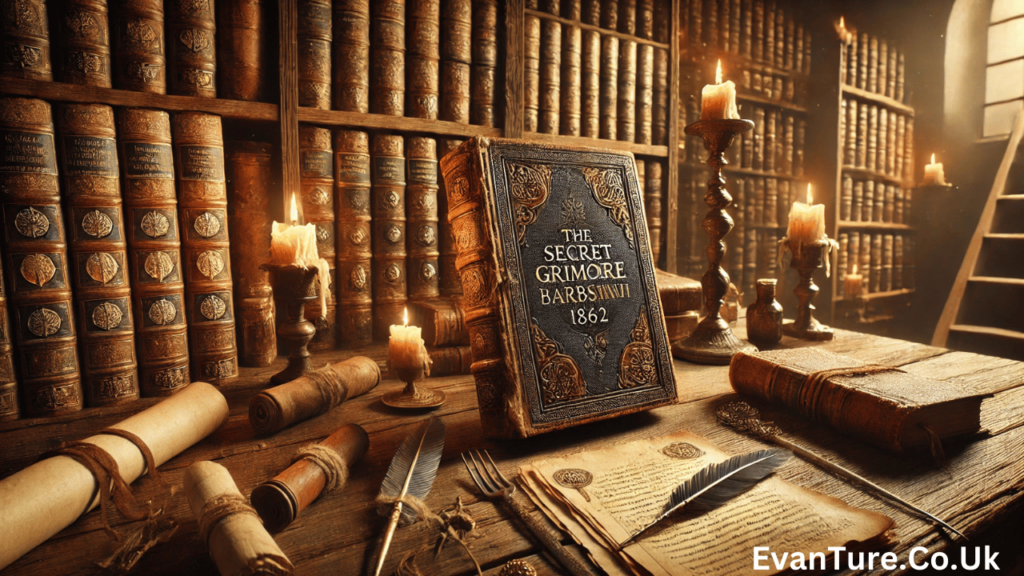In the world of esoteric literature and occult manuscripts, few works remain as mysterious and captivating as “The Secret Grimoire of Barbara Hudsoniuc 1862“. This enigmatic text, attributed to the little-known figure Barbara Hudsoniuc, has sparked intrigue among historians, occult enthusiasts, and bibliophiles alike. Shrouded in secrecy, the grimoire is said to hold powerful spells, rituals, and mystical knowledge from a time when spiritualism and mysticism flourished. But what exactly makes this book so significant? Let delve into the history, content, and cultural impact of this elusive 19th-century manuscript.
The Historical Context of 1862: A Time of Spiritual Exploration
The year 1862 was a fascinating period in history, marked by the rise of spiritualism and the increasing popularity of occult practices. This era saw a growing fascination with the metaphysical world, as people sought answers beyond the physical realm. Mediums, seances, and mystical texts became widely popular, offering glimpses into what was believed to be hidden truths about the universe.
Barbara Hudsoniuc grimoire emerged during this time, embodying the spirit of curiosity and exploration that defined the mid-19th century. The grimoire, though obscure, aligns with other occult texts of its time, such as those inspired by Hermeticism, alchemy, and the Kabbalah. The precise circumstances surrounding its creation remain unclear, but its content reflects a deep understanding of both mysticism and ancient traditions.
Who Was Barbara Hudsoniuc?
Barbara Hudsoniuc is an enigmatic figure whose life remains largely undocumented. Unlike prominent occultists of her time, such as Eliphas Lévi or Madame Blavatsky, Hudsoniuc left behind no known personal records or other works beyond her grimoire. This lack of information has led some to question whether she was a real person or a pseudonym used to mask the true author identity.
Despite the mystery, certain clues within The Secret Grimoire of Barbara Hudsoniuc 1862 suggest that its author was well-versed in mystical traditions and likely connected to underground occult circles. The text intricate descriptions of rituals and symbolism point to a learned individual with access to rare sources of esoteric knowledge. Whether Hudsoniuc was a solitary practitioner or part of a larger movement, her work continues to captivate modern readers.
Exploring the Content of The Secret Grimoire of Barbara Hudsoniuc 1862
Spells and Rituals
At its core, The Secret Grimoire of Barbara Hudsoniuc 1862 serves as a manual for magical practices. The book contains detailed instructions for conducting rituals, casting spells, and invoking spiritual entities. These practices are rooted in a blend of ancient traditions, drawing inspiration from European folklore, Hermetic principles, and possibly even Eastern mysticism.
Some of the most notable spells in the grimoire include:
- Protection Rituals: Designed to ward off negative energies and protect the practitioner from harm.
- Love and Binding Spells: Methods to influence emotions and relationships.
- Divination Techniques: Tools and rituals for gaining insight into future events or hidden truths.
The rituals are often accompanied by symbolic illustrations and cryptic passages, requiring careful interpretation by the reader.
Alchemy and Symbolism
Another prominent theme in the grimoire is alchemy, which was a cornerstone of many occult texts during the 19th century. The book contains references to transmutation—both physical and spiritual—symbolizing the practitioner journey toward enlightenment.
Hudsoniuc use of symbolism is particularly fascinating. The text features intricate diagrams, sigils, and alchemical symbols, each representing different aspects of the magical process. For instance, the serpent—a recurring motif—is used to signify transformation and the cyclical nature of life and death.
Philosophical Teachings
Beyond its practical applications, The Secret Grimoire of Barbara Hudsoniuc 1862 also delves into philosophical concepts. The text explores the relationship between the material and spiritual worlds, emphasizing the importance of balance and harmony. Hudsoniuc writings reflect a deep understanding of metaphysics, encouraging readers to seek inner wisdom and connect with the divine.
The Cultural Impact of The Secret Grimoire of Barbara Hudsoniuc 1862
A Hidden Gem Among Occult Texts
While many grimoires from the 19th century have gained widespread recognition, The Secret Grimoire of Barbara Hudsoniuc 1862 remains relatively obscure. This may be due to its limited distribution or the secrecy surrounding its author. However, those who have studied the text often regard it as a hidden gem, offering unique insights into 19th-century mysticism.
Influence on Modern Occultism
Despite its obscurity, the grimoire has influenced contemporary practitioners and scholars. Elements of Hudsoniuc rituals and philosophies have been incorporated into modern occult practices, demonstrating the enduring relevance of her work. Additionally, the text has become a subject of academic interest, with researchers examining its historical and cultural significance.
Mysteries and Speculations
The lack of concrete information about Barbara Hudsoniuc and her grimoire has led to various theories and speculations. Some believe the text was deliberately shrouded in mystery to protect its secrets, while others suggest it may be a forgery or a modern creation inspired by 19th-century traditions. Regardless of its origins, the grimoire allure lies in its ability to spark curiosity and imagination.
Why The Secret Grimoire of Barbara Hudsoniuc 1862 Matters Today
In a world where science and technology dominate, the enduring fascination with occult texts like The Secret Grimoire of Barbara Hudsoniuc 1862 highlights humanity timeless quest for knowledge and meaning. The grimoire serves as a reminder of the rich history of mysticism and the ways in which it continues to shape our understanding of the universe.
For modern readers, the grimoire offers more than just a glimpse into the past; it provides inspiration for personal growth and exploration. Whether viewed as a historical artifact or a source of spiritual guidance, Hudsoniuc work remains a testament to the enduring power of the mystical and the unknown.
FAQs About The Secret Grimoire of Barbara Hudsoniuc 1862
1. What is The Secret Grimoire of Barbara Hudsoniuc 1862? The Secret Grimoire of Barbara Hudsoniuc 1862 is a 19th-century occult manuscript attributed to Barbara Hudsoniuc. It contains spells, rituals, and philosophical teachings rooted in mysticism and alchemy.
2. Who was Barbara Hudsoniuc? Barbara Hudsoniuc is an enigmatic figure with little known about her life. She is believed to have been a practitioner of the occult, though her true identity remains a mystery.
3. What does the grimoire contain? The grimoire includes instructions for magical practices, alchemical symbolism, and philosophical teachings. It is a blend of ancient traditions and 19th-century mysticism.
4. Why is the grimoire significant? The grimoire is significant for its unique blend of mystical practices and its reflection of the spiritual exploration that characterized the 19th century. It remains a valuable resource for both historians and modern occult practitioners.
5. Is The Secret Grimoire of Barbara Hudsoniuc 1862 authentic? The authenticity of the grimoire is debated. While some believe it to be a genuine 19th-century text, others speculate it may be a forgery or modern creation inspired by historical traditions.
Conclusion
The Secret Grimoire of Barbara Hudsoniuc 1862 stands as a captivating piece of esoteric history, blending mysticism, philosophy, and magical practices into a unique artifact of the 19th century. Whether a genuine historical manuscript or a cleverly crafted creation, it continues to intrigue and inspire those who seek to understand the mysteries of the metaphysical world. Its enduring legacy is a testament to humanity unending curiosity about the unknown and the timeless allure of the mystical.
Read More: Is It Safe to Can You Use a Leaf Blower Wit Heusphatian Tube Dysfunction







